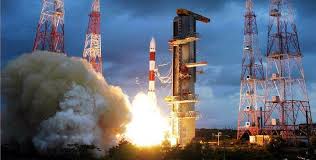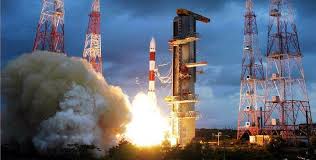
There would be another “mini Hubble” space observatory from Monday with ISRO, India’s premier space research agency launching its first space research observatory ASTROSAT, along with a number of US satellites.
“This is one more grand accomplishment for Indian science and our scientists,” tweeted the Indian Prime Minister Narendra Modi congratulated the Indian Space Research Organisation (ISRO) on the successful launch. Modi is on a state visit to the US to attend the United Nations General Assembly.
The indigenous telescope would be able to observe distant celestial objects in visible and ultraviolet light, as well as the entire X-ray waveband. These would allow deep analysis of far off star systems.
While the Indian space program has not seen a smooth going with hiccups and with many planned missions cancelled or delayed over the last ten years, the successful maiden Mars mission attempt of ISRO last year was a feather in its cap.
ISRO received accolades for its maiden successful Mars mission for on two countrs – the mission was completed at a fraction of the cost of similar NASA missions and it was the successful in its first attempt which had not been possible of rthe earlier there successful missions to Mars by by Roscosmos, NASA and the European Space agency.
The Mars Orbiter Mission (MOM), or Mangalyaan project by ISRO had a total bill of around $73 million while the NASA’s MAVEN mission, which reached Mars just a few days ahead of Mangalyaan, cost around $671 million.
Six foreign satellites were carried aboard a PSLV-C30 India’s Polar Satellite Launch Vehicle, in Monday’s ASTROSAT observatory launch. The India’s Polar Satellite Launch Vehicle has had 31 successful missions and launched 84 satellites including Monday’s said a communiqué from ISRO.
To ensure it was at its final operational configuration and all five of its scientific payloads were working properly before it starts regular operations, ASTROSAT would be put through its paces in the next few days, said ISRO.
The Inter University Centre for Astronomy and Astrophysics (IUCAA) of Pune, Bhabha Atomic Research Centre and Tata Institute of Fundamental Research (TIFR) at Mumbai, Indian Institute of Astrophysics (IIAP) and Raman Research Institute (RRI) of Bangalore and SN Bose National Centre for Basic Sciences in Kolkata jointly built the payloads and the observatory. Two the Canadian Space Agency and the University of Leicester in the UK were also part of the project.
All of the three of ASTROSAT’s X-ray observers was built by TIFR. The three X-ray observer that were delivered to space included a Large Area Xenon Proportional Counters (LAXPC), a Soft X-ray Telescope (SXT) and a Cadmium-Zinc-Telluride Imager (CZTI).
“The instruments developed by TIFR will give us a capability unrivalled in the world for the next five to ten years. We look forward to some great science results,’” said Professor S. Trivedi, Director of TIFR, in a statement.
The other scientific payloads are the Ultraviolet Imaging Telescope (UVT) and the Scanning Sky Monitor (SSM), which is very similar to the All Sky Monitor on NASA’s RXTE satellite. ASTROSAT is also equipped with a Charged Particle Monitor to control the operation of the LAXPC, SXT and SSM.
(Source:www.forbes.com)
“This is one more grand accomplishment for Indian science and our scientists,” tweeted the Indian Prime Minister Narendra Modi congratulated the Indian Space Research Organisation (ISRO) on the successful launch. Modi is on a state visit to the US to attend the United Nations General Assembly.
The indigenous telescope would be able to observe distant celestial objects in visible and ultraviolet light, as well as the entire X-ray waveband. These would allow deep analysis of far off star systems.
While the Indian space program has not seen a smooth going with hiccups and with many planned missions cancelled or delayed over the last ten years, the successful maiden Mars mission attempt of ISRO last year was a feather in its cap.
ISRO received accolades for its maiden successful Mars mission for on two countrs – the mission was completed at a fraction of the cost of similar NASA missions and it was the successful in its first attempt which had not been possible of rthe earlier there successful missions to Mars by by Roscosmos, NASA and the European Space agency.
The Mars Orbiter Mission (MOM), or Mangalyaan project by ISRO had a total bill of around $73 million while the NASA’s MAVEN mission, which reached Mars just a few days ahead of Mangalyaan, cost around $671 million.
Six foreign satellites were carried aboard a PSLV-C30 India’s Polar Satellite Launch Vehicle, in Monday’s ASTROSAT observatory launch. The India’s Polar Satellite Launch Vehicle has had 31 successful missions and launched 84 satellites including Monday’s said a communiqué from ISRO.
To ensure it was at its final operational configuration and all five of its scientific payloads were working properly before it starts regular operations, ASTROSAT would be put through its paces in the next few days, said ISRO.
The Inter University Centre for Astronomy and Astrophysics (IUCAA) of Pune, Bhabha Atomic Research Centre and Tata Institute of Fundamental Research (TIFR) at Mumbai, Indian Institute of Astrophysics (IIAP) and Raman Research Institute (RRI) of Bangalore and SN Bose National Centre for Basic Sciences in Kolkata jointly built the payloads and the observatory. Two the Canadian Space Agency and the University of Leicester in the UK were also part of the project.
All of the three of ASTROSAT’s X-ray observers was built by TIFR. The three X-ray observer that were delivered to space included a Large Area Xenon Proportional Counters (LAXPC), a Soft X-ray Telescope (SXT) and a Cadmium-Zinc-Telluride Imager (CZTI).
“The instruments developed by TIFR will give us a capability unrivalled in the world for the next five to ten years. We look forward to some great science results,’” said Professor S. Trivedi, Director of TIFR, in a statement.
The other scientific payloads are the Ultraviolet Imaging Telescope (UVT) and the Scanning Sky Monitor (SSM), which is very similar to the All Sky Monitor on NASA’s RXTE satellite. ASTROSAT is also equipped with a Charged Particle Monitor to control the operation of the LAXPC, SXT and SSM.
(Source:www.forbes.com)





